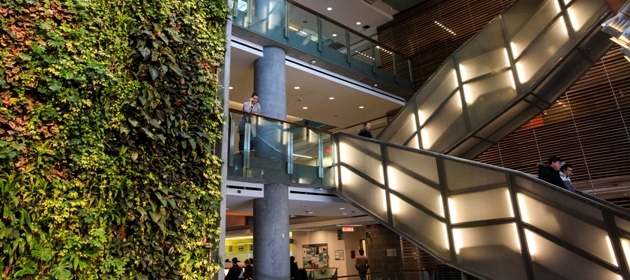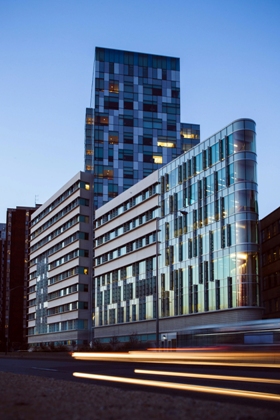One of the major hubs of activity during Congress 2015 will be the Social Sciences Building, which houses the University of Ottawa’s largest faculty. Inaugurated in the fall of 2012, the modern, light-filled structure gathers the entire Faculty of Social Sciences — more than 10,000 students, 260 full-time professors and 100 staff — under one roof. For first time in the faculty’s 60-year history, its departments, schools and institute are no longer scattered all over campus.
The 15-storey tower in the heart of campus will be the site of the Big Thinking series at Congress and of several association conferences. The Beer Tent will be located just outside its front entrance in an adjacent parking lot.
One of the building’s most eye-catching features is a five-storey biofilter living wall — the tallest in North America. Covered in a variety of plants, the wall acts as the building’s air filtration system and provides humidity. The tower also houses a 225-seat lecture theatre and the School of Psychology’s INSPIRE lab, a cutting-edge facility that combines neuroscience with the social sciences to better understand how people think, behave or react to different stimuli, such as political speeches or advertisements.
Sustainable design and construction are what sets the Social Sciences Building apart from most others on campus. Winner of a number of building awards, the LEED Gold-certified facility meets strict environmental guidelines. Some of its eco-friendly features include:
• Construction materials were selected for their recycled content and locally sourced as much as possible.
• 80 percent of the building’s heating needs are met through heat redistribution. The heat created by the building’s data centre is recycled to heat it and other neighbouring structures.
• The building consumes 50 % less energy (cooling, heating and lighting) than what is permitted by the Model National Energy Code for Buildings.
• Some of the roofs are covered in gardens to provide thermal insulation.
An architectural gem, the Social Sciences Building also sets an important precedent that will likely influence future green development at the University of Ottawa.
Images: University of Ottawa


